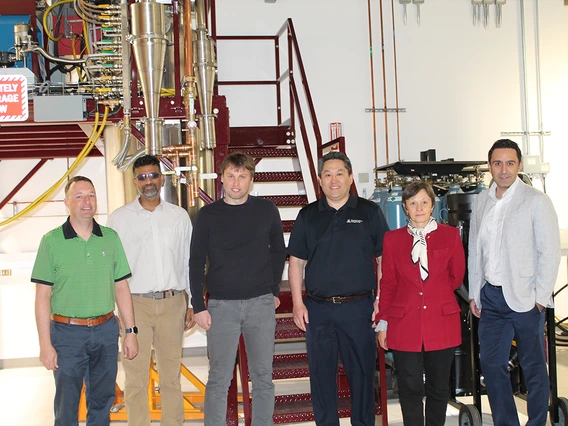Navy funds hypersonic heat reduction research
With $750,000 from a young investigator award, AME’s Kyle Hanquist investigates gas interactions at ultra-fast speeds.

Assistant professor Kyle Hanquist is director of the University of Arizona’s Computational Hypersonics and Nonequilibrium Laboratory and a founding faculty member of the Arizona Research Center for Hypersonics.
The Office of Naval Research selected Kyle Hanquist, assistant professor of aerospace and mechanical engineering, to receive a 2025 Young Investigator Program award. Hanquist has proposed a solution to a dilemma engineers face in designing ultra-fast aircraft: The very features that enhance speed – like sharp leading edges that reduce drag – also produce intense heat.
With the three-year, $750,000 grant, Hanquist will explore use of plasmas for heat management. Plasmas are electrically charged gases that form naturally around vehicles when they travel at hypersonic speeds, which is faster than Mach 5, or five times the speed of sound.
“This award is well-deserved recognition of Dr. Hanquist’s groundbreaking research in hypersonics,” said Farzad Mashayek, AME department head.
Young investigator awards are intended to help awardees take risks and explore novel ideas, said Hanquist.
“I believe this project reflects that, and I’m excited to get to work,” Hanquist said, adding that the award will fund the work of four students who will assist. Two are undergraduates and two are graduate students.
Speeding up, cooling down
Hanquist is focusing on thermionic emission, which occurs when the vehicle’s surface reaches temperatures as high as 4,000 degrees Fahrenheit and the flow field, or surrounding air, heats to as much as 18,000 degrees Fahrenheit. Under these conditions, electrons escape from the surface, forming plasma that may carry away thermal energy and help cool the material. While scientists discovered the underlying phenomenon more than a century ago, the ability of thermionic emission to cool high-temperature aerospace surfaces remains unknown.
Hanquist’s aims to understand how plasmas, created by thermionic emissions from the surfaces of hypersonic vehicles, interact with hot leading edges in complex airflows. He will leverage that knowledge to develop cooling methods.
Hanquist and his team will use modeling and simulation to study how plasmas interact with hypersonic vehicle surfaces and help manage intense heat loads. They will also conduct experiments that simulate extreme thermal conditions to validate their models and assess whether thermionic emission can effectively cool hot aerospace surfaces.

Hypersonic vehicles feature sharp leading edges that contribute to extreme heat generation during flight.
Serving the nation
The ONR Young Investigator Program is a highly competitive program that attracts early-career academic researchers who demonstrate promise in advancing scientific and technological solutions relevant to the U.S. Navy and Marine Corps.
Established in 1985, it is one of the nation’s oldest and most selective basic-research, early-career awards in science and technology. The program supports cutting-edge research in areas critical to naval operations while fostering the development of future leaders in science and engineering.
Hanquist joined the faculty in 2019 from the University of Michigan, where he earned a doctoral degree and completed a postdoctoral fellowship.


